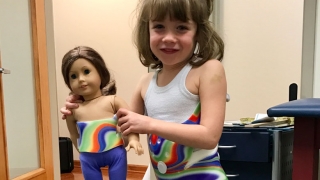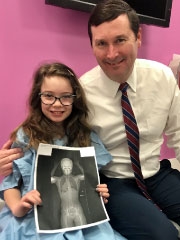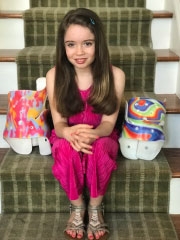Emma’s Story: Bracing for Scoliosis
Published on
Published on
A diagnosis of pneumonia led to the discovery that 4-year-old Emma had scoliosis. When the curve in her spine progressed from 15 degrees to 42 degrees in a little over a year, her family worried she would need surgery. But their diligence in adhering to Emma’s bracing treatment plan produced an amazingly rare outcome.
When Emma was 4 years old, she came down with a bad cold. She had a high fever and was struggling to breathe. Her parents, Pam and Mike, were concerned so they called their primary care physician (PCP) to make an appointment. Upon hearing Emma’s symptoms, the doctor recommended the family go directly to the ER near their home in Collegeville, Pa. It was a good call, as a chest X-ray showed Emma had pneumonia.
Pneumonia wasn’t the only thing visible on the X-ray. A week after the ER visit, Emma’s PCP called Pam and said they had received a copy of the X-ray and noticed Emma had scoliosis. Once again, the PCP saved the day.
“We were very lucky,” says Pam.
 Emma shows off her brace.
The PCP recommended Emma see an orthopaedic specialist from Children’s Hospital of Philadelphia (CHOP). Fortunately, Emma was able to be seen at CHOP’s Specialty Care Center in King of Prussia, Pa. The Specialty Care location offers the same level of orthopaedic care provided at the hospital, but at a more convenient location for families that live outside the city, like Emma’s.
Emma shows off her brace.
The PCP recommended Emma see an orthopaedic specialist from Children’s Hospital of Philadelphia (CHOP). Fortunately, Emma was able to be seen at CHOP’s Specialty Care Center in King of Prussia, Pa. The Specialty Care location offers the same level of orthopaedic care provided at the hospital, but at a more convenient location for families that live outside the city, like Emma’s.
“The facility in King of Prussia is so amazing, well equipped and very efficient,” says Pam. “It’s extremely accommodating to be able to drive down the road for that level of care. We feel very lucky.”
During her evaluation with CHOP’s Spine Program at the Specialty Care Center, Emma underwent an X-ray in an EOS machine, which uses an ultra-low dose of radiation to provide extremely detailed, high-quality images. The EOS machine estimated the curvature of Emma’s spine to be 14 degrees. The care team explained the diagnosis to Pam and Mike and what the degree of Emma’s curvature meant. Emma had juvenile idiopathic scoliosis. Unlike adolescent idiopathic scoliosis — an abnormal curvature of the spine that appears in late childhood or adolescence — juvenile idiopathic scoliosis is typically diagnosed between ages 4 and 10. Emma’s curve wasn’t severe and didn’t warrant treatment, but because she was so young and scoliosis can be progressive, she would need to be closely monitored until she stopped growing.
“We feel very lucky that CHOP has an EOS X-ray machine,” says Mike. “That is incredibly important and not available in many facilities. For someone so young, to be having X-rays at least three times a year until she’s 18, getting less radiation is really important.”
 Emma with Dr. Flynn.
EOS imaging six months later showed the curve in Emma’s spine had progressed to 26 degrees. It was time to take action. Back bracing is typically the first line of treatment against a worsening spinal curve. Results of a 2013 study conducted at CHOP and other major scoliosis treatment centers proved that braces are very successful in halting the progression of juvenile idiopathic scoliosis. Emma was measured for a brace immediately. She had to wear it 20 hours a day for the next three years.
Emma with Dr. Flynn.
EOS imaging six months later showed the curve in Emma’s spine had progressed to 26 degrees. It was time to take action. Back bracing is typically the first line of treatment against a worsening spinal curve. Results of a 2013 study conducted at CHOP and other major scoliosis treatment centers proved that braces are very successful in halting the progression of juvenile idiopathic scoliosis. Emma was measured for a brace immediately. She had to wear it 20 hours a day for the next three years.
“It was a whirlwind,” says Mike. “Getting the diagnosis, seeing the progression, and then having to be braced 20 hours a day.”
The CHOP team put Emma’s family in contact with the Curvy Girls Foundation, an international network of scoliosis support groups for teen girls. Support group meetings were instrumental in helping Emma stay compliant with the brace and know that she isn’t alone in her struggles.
“Hearing the other girls share their challenges in group prepared her,” says Pam. “They are role models to her. They are coping and dealing with their diagnosis, and so it helps her see that she can, too.”
“The brace is uncomfortable, and it pinches me,” says Emma. “When I would wear it to school, other kids would knock on it and say, ‘What’s that? Why do you have to wear that?’ I would explain it to them over and over again, but it was a little embarrassing to be different.”
During her three years wearing the brace, there were a lot of things Emma discovered she couldn’t do while wearing it — like cartwheel. But one thing she realized she could do that none of her friends could is ‘brace dance.’
“Emma figured out how to lay on the ground in her brace and spin around,” says Pam. “We thought, ‘Well, you know what, that’s one thing you can do that no other kids can.’”
“It’s great,” says Emma.
 Emma has achieved great outcomes from sticking to her bracing therapy.
A growth spurt during Emma’s first year wearing the brace sent her curve from 26 degrees to 42 degrees.
Emma has achieved great outcomes from sticking to her bracing therapy.
A growth spurt during Emma’s first year wearing the brace sent her curve from 26 degrees to 42 degrees.
“We were worried she might need surgery,” says Mike. At such a young age, if Emma’s curve progressed to surgery range — which is around 50 to 60 degrees — she would have needed multiple spinal fusion surgeries to allow her to continue to grow.
Thankfully, she was fitted for a new, longer brace, which was not only successful in halting progression of the curve, but actually reversed it. In September 2019, Emma’s curve was down to 20 degrees. As a result of the reversal, she was able to take an eight-month break from wearing the brace, which was a big relief to her.
“Emma has had a great response to bracing,” says Dr. Flynn, Chief of CHOP’s Division of Orthopaedics. “It is extremely rare for bracing to improve scoliosis that much in teens who have adolescent idiopathic scoliosis. This is something that happens infrequently for individuals with juvenile idiopathic scoliosis and only if they are diligent with their bracing program.”
Emma’s success didn’t come without a struggle, and there may be more challenges ahead for her. But she knows now that doing the hard work of wearing the brace pays off.
“One of the reasons Emma wanted to tell her story is because it’s really tough to be compliant with the brace,” says Pam. “With her story, look what can happen if you’re compliant. It can not only hold your curve, it can correct it. Chances are she’ll have to wear it again. But she has this experience where her compliance allowed her to have an eight-month break.”